Exploring Hand Lenses in Botany: A Detailed Overview
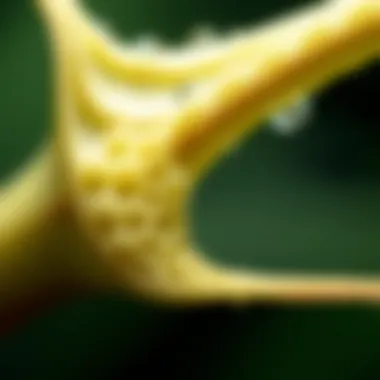
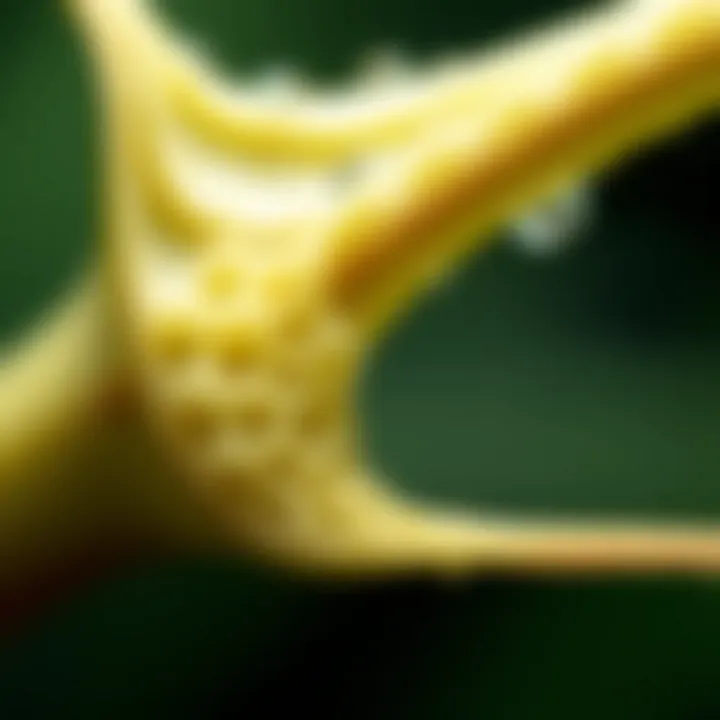
Intro
The world of botany is rich and varied, teeming with intricacies that often escape the untrained eye. Many enthusiasts and professionals are keen to understand plant structures on a deeper level, and this is where hand lenses come into play. These seemingly simple tools play a crucial role in magnifying details that would otherwise be overlooked. With the right hand lens, a botanist can unlock the secrets hidden in leaves, stems, and flowers, enhancing their overall understanding of plant anatomy.
This guide aims to shed light on the significance of hand lenses in botanical study, focusing on their historical development, various applications, and practical insights for use. By examining these aspects, we hope to provide both novices and seasoned botanists with a comprehensive understanding of how hand lenses can deepen their appreciation for the plant kingdom.
History and Origins
The journey of hand lenses in botany can be traced back centuries, reflecting humanity's relentless quest to understand the natural world. Early botanists relied on rudimentary instruments made from glass or even polished stone. These primitive devices laid the groundwork for more advanced optical tools that would later flourish.
Historical Significance and Cultural Impact
Throughout history, the role of hand lenses has evolved in tandem with botanical study. Originally, these tools were mostly used in the context of herbarium specimens—dried plants meticulously pressed and preserved for study. The introductions of botanical illustration also benefited immensely from the precision that hand lenses provided. Notable figures in botany, such as Carl Linnaeus, used magnification tools, although they might have had more primitive forms than what we know today.
As time went on, the significance of hand lenses expanded, particularly during the Age of Enlightenment. This period saw a surge in interest towards the natural sciences, with many explorers and botanists using hand lenses to document flora from exotic locales. These early uses highlight how hand lenses have not only facilitated scientific discovery but have also deeply influenced cultural perceptions of nature.
"A hand lens is not just a tool; it’s a gateway to a world often hidden in plain sight."
The revival of interest in botany during the 19th century propelled new advancements in optics, leading to the creation of better and more efficient hand lenses that were widely accessible. This democratization of knowledge enabled not just professionals but also amateurs to engage more fully with the plant world.
As we look back, it is evident that hand lenses have played a significant role in shaping how we study and understand botany, ultimately fostering a greater appreciation for the variety and complexity of plant life.
Identification and Classification
Botanical observation carries with it the weight of responsibility and curiosity. When identifying plant species, the minutiae of structures such as flower parts, leaf venation, and trichomes can provide critical information. Here’s a closer look at how hand lenses facilitate this process.
Guide to Identifying Plant Structures
- Flower Anatomy: By seeing the stamens and pistils clearly, you can differentiate between species that may look similar at first glance.
- Leaf Characteristics: The surface detailing, including texture and pore patterns, becomes more pronounced when magnified.
- Trichomes: These tiny hair-like structures are important for categorizing plants and can reveal the plant's adaptations to its environment.
Common Types of Hand Lenses and Variations
- Simple Hand Lens: The straightforward design typically has a single convex lens and is lightweight, making it easy to carry.
- Bifocal Hand Lens: This type offers two levels of magnification, which is perfect for viewing both large structures and intricate details.
- LED Lighted Lens: Integrated lighting allows for better visibility in low-light conditions, making it easier to observe specimens in the field.
Understanding these varied applications and types enhances the ability to engage with the plant kingdom more meaningfully. Whether you are a professional botanist or simply a passionate hobbyist, the right hand lens can drastically improve your observational skills and understanding of plant life.
Prelude to Hand Lenses in Botany
In the realm of botany, where the minute details of plant structure can hold crucial secrets, the use of hand lenses emerges as a fundamental tool. They are not merely magnifying glasses but gateways to a deeper understanding of the botanical world. With their ability to bring forth the complexity of plant anatomy, hand lenses enhance both the amateur and professional botanist's experience, bridging the gap between mere observation and scientific inquiry.
The importance of hand lenses in botany stems from their practicality and ease of use. These lenses allow for close inspection of features such as leaf venation, flower structures, and other intricate details often missed by the naked eye. While digital devices have made their mark, nothing replicates the tactile and immersive experience provided by a simple hand lens. Their portability means botanists can bring them into the field, allowing for spontaneous exploration and study, regardless of location.
Apart from facilitating identification, hand lenses serve a critical educational purpose. For students and novices, they offer hands-on experience, making the study of botany more engaging and intuitive. Understanding this tool's definition and purpose is vital for appreciating its role in botanical observation.
Additionally, it is essential to recognize the evolution of botanical observation tools. From primitive versions carved from natural materials to modern optical designs, the history surrounding these instruments reflects broader trends in science and technology. By tracing the lineage of hand lenses, one can better appreciate their place in the scientific toolkit of today.
"The difference between an observed plant and a studied plant can often be the use of a hand lens. What looks like a mundane leaf might reveal a whole world of structures when examined closely."
Through this guide, we will explore all facets of hand lenses in botany, from their specifications and applications to practical usage techniques and equipment care. Let's delve into their definition and purpose next.
Types of Hand Lenses
Understanding the varieties of hand lenses available is crucial for anyone serious about botanical observation. Each type serves a unique purpose, and the selection can significantly influence the quality of your examination.
Investing time to comprehend the different types can enhance your field experience, whether you're observing the texture of leaves or the delicate structure of a flower's reproductive parts. Plus, selecting the right tool could mean the difference between a brief glance and a detailed exploration.
Conventional Hand Lenses
Conventional hand lenses, often made from glass with a single lens design, have been around for ages. These devices are straightforward—just a magnifying lens in a frame, sometimes with a handle for ease of use. Their simplicity is part of their charm, as they can be used quickly without fuss.
The magnification usually ranges from 5x to 10x, which is sufficient for looking at various plant features, like leaf veins or trichomes. One notable advantage is their portability; slipping it into a pocket after a quick observation is a breeze. They are especially popular among beginners due to their easy handling.
However, conventional hand lenses do come with limitations. They often lack the broader field of view that some more advanced models provide. Also, quality can differ drastically, with some produced using lower-grade materials that can distort images under certain conditions.
LED Hand Lenses
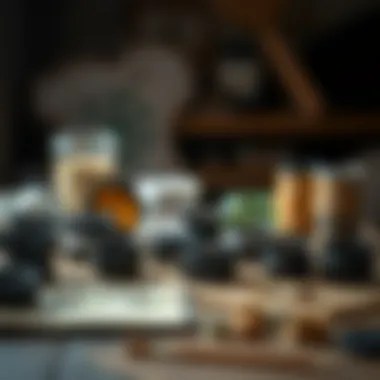

Brightening up observations, LED hand lenses integrate an illumination source right into the design. This feature is particularly beneficial for examining plants in shady environments or indoors where light might be scarce. The built-in LED lights up the area being observed, revealing features that might otherwise go unnoticed.
Typically, you’ll find these lenses offering similar magnification options as conventional types, yet the illumination can change the game entirely. They are particularly useful when inspecting fine details like the surface patterns on seeds or the intricate structures of flowers.
One aspect to consider is the battery life. LED hand lenses can require regular checks or replacements, and it's something to keep in mind, especially during extensive field studies. Some models even come with adjustable brightness settings, which makes them versatile for different observation conditions.
Multi-Magnification Hand Lenses
As the name suggests, multi-magnification hand lenses allow you to switch between different magnification levels with ease. This feature is particularly advantageous for botanists interested in examining varying details—say, from an overview of a leaf to the minute structures within a flower.
These lenses typically come with different settings, offering magnifications ranging from 2x to 20x or more. This functionality can save time and effort, providing an on-the-fly adjustment rather than needing to switch lenses in the field continually.
While such versatility comes at a price—both in terms of cost and weight—many find the investment worthwhile. Besides, some models boast additional features, like built-in LED lighting, making them a complete package for serious botanical enthusiasts.
The right hand lens can be your best ally in uncovering the often-hidden wonders of the plant kingdom. Choosing wisely can enrich your experience and ensure you don’t miss the fine details that tell a plant's story.
Selecting the Right Hand Lens
Choosing the right hand lens is critical for any botanist—be they a seasoned researcher or a curious hobbyist. A well-suited hand lens can be the difference between a general understanding of plant structures and uncovering the fine details that tell a unique story about species, their behaviors, and their habitats. It’s not just about seeing; it’s about understanding, connecting the dots to form a clearer picture of the botanical world. Factors like magnification, aperture, and materials can significantly influence the effectiveness of this tool in your study sessions.
Understanding Magnification and Aperture
Magnification is perhaps one of the most straightforward considerations when picking a hand lens. Ranges can vary, with some lenses providing 2x magnification and others offering up to 10x or more. It’s crucial to analyze what you want to observe. For instance, if your focus is on the minutiae of a flower's stamen or the microscopic layout of leaf surfaces, then a higher magnification will be beneficial. However, too much magnification can lead to a narrow field of view—these lenses might skew your perception of plant characteristics.
Apart from magnification, aperture plays its own vital role. A wider aperture allows more light to enter, enhancing clarity at higher magnifications. You’ll want a balance that provides decent light while maintaining a practical size that doesn't become cumbersome in the field.
Field of View Considerations
The field of view refers to how much of the sample you can see through the lens. A limited field can lead to missed details or crucial aspects of a plant that might be vital for identifying species or understanding adaptations. Always consider the context in which you’ll work. In densely packed environments or while examining tiny flowers, a broader field can save you the hassle of manipulating the hand lens too much. If you are expected to identify plants with varied morphology or if you’re on the hunt for specific traits, a wider field of view becomes invaluable.
Comparative Analysis of Lens Materials
When it comes to hand lenses, material makes a big difference in durability and optical quality. Glass lenses are more commonly favored for their clarity and scratch resistance; however, they can be heavier and more fragile with rough handling. On the other hand, plastic lenses are lighter and often more durable, yet they tend to scratch more easily and may not offer the same optical fidelity. It’s important to weigh these attributes against your intended use. If you’re venturing into rugged terrain or areas where accidental drops might happen, a durable plastic lens could be the ticket. But, if your goal is precision and detail, investing in a glass model might yield better long-term benefits.
"Selecting the right hand lens is akin to ensuring that the compass points you not just towards the plants, but towards understanding their essence."
In summary, selection isn’t just a few quick decisions—it’s a multi-faceted approach that lends itself to better observation, study, and ultimately, a richer appreciation of the botanical world. Taking the time to analyze these elements can enhance your insights, making each encounter with plants a more enriching experience.
For further reading on hand lenses and magnification, you might consider visiting Wikipedia or engaging in discussions on plant observation on platforms like Reddit.
Applications in Botanical Research
The role of hand lenses in botanical research can hardly be overstated, as they become an essential tool in the pursuit of knowledge concerning plant life. With a focus on enhancing observation, these instruments allow both scholars and enthusiasts to gain a more profound connection with the intricacies of flora. Let's explore some specific applications that underscore the significance of hand lenses in botanical studies.
Identifying Plant Species
Hand lenses provide botanists and plant enthusiasts the ability to examine minute details that can lead to accurate species identification. For instance, the unique patterns on leaves can be discerned more clearly under magnification. Structures like trichomes and stomata are often crucial in distinguishing closely related species. In a practical sense, using a hand lens can turn a simple stroll through the woods into an engaging detective story, revealing hidden clues tucked away on leaves, stems, and flowers.
To get specific, consider how the shape of a leaf’s margin, whether serrated or smooth, can reveal much about its identity. The lens allows one to see not just what the leaf looks like overall but also the small features that indicate its family or genus.
Studying Plant Structures
Delving deeper into the anatomy of plants is where hand lenses shine brightest. Botany is not solely about identifying what plants are; it is also about understanding how they work. Focusing on plant structures like cells, vascular tissues, and reproductive organs through a hand lens opens up a new world of discovery. For instance, assess the microscopic details of flower structures to understand their function in reproduction, or explore the composition of xylem and phloem to see how a plant transports nutrients.
When you scrutinize a leaf’s surface, you might notice minute waxy layers, signifying adaptations to environments. Each feature holds stories of evolutionary change and adaptation worth noting down in field journals.
Examining Pollination Mechanisms
Another captivating application for hand lenses is the study of pollination mechanisms. The intersection of anatomy and behavior comes alive when you magnify floral structures. Observing the intricate design of a flower is not only a visual treat but a gateway to understanding its attraction strategies meant for specific pollinators.
By closely inspecting pollen grains, for example, researchers can identify affinities or preferences of various pollinators, be it bees, bats, or even birds. These interactions play a pivotal role in ecosystems and biodiversity, illuminating the delicate web that sustains plant life. Specifically, discovering the exact positioning of nectar and the textures of anthers can hint at which insects are best suited for pollination, a fact that can make or break an entire ecological cycle.
"The closer you look, the more you see. Each minute detail has a story to tell about our natural world."
In sum, the applications of hand lenses in botanical research go beyond mere observation; they enhance understanding, elevate accurate classifications, and foster a more profound appreciation of the marvels of nature. As tools for both identification and research, hand lenses remain a bridge connecting practical fieldwork to the theoretical realms of botany.
Practical Usage Techniques
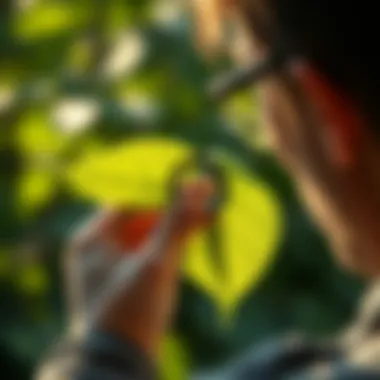
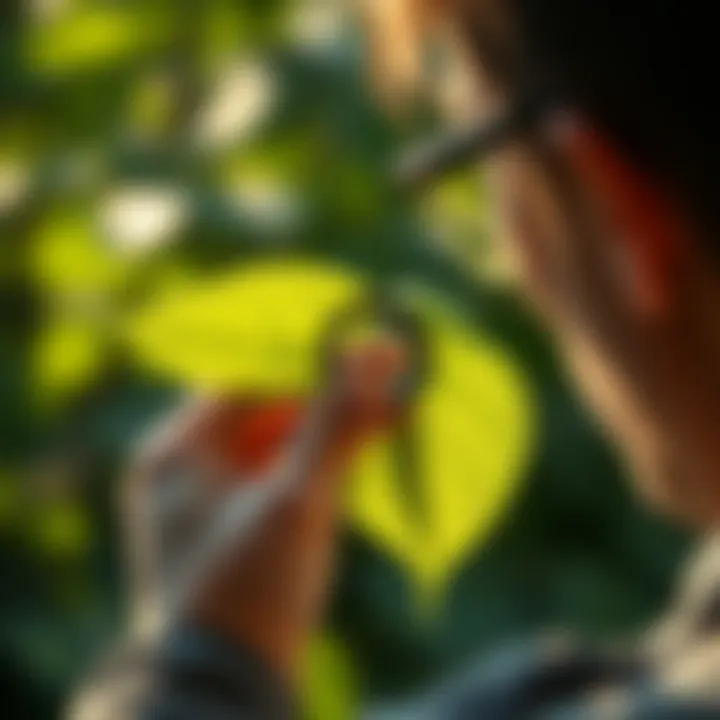
Practical usage techniques often set apart the novice botanist from the seasoned expert. Understanding how to effectively use hand lenses not only enhances observation but also deepens the appreciation for the intricate details that plants offer. As each botanist sets out, be it into dense woodland or a simple garden, having the right approach equips them to extract the utmost knowledge from their surroundings. Properly utilizing hand lenses can save time, reduce frustration, and markedly increase success in identifying specific plant species or observing structures.
Best Practices for Using Hand Lenses
To leverage hand lenses effectively, practitioners should embrace several best practices:
- Familiarize with Specifications: Know your hand lens. Consider the magnification level, aperture size, and quality of glass. Clear optics are a non-negotiable; blurred images can lead to incorrect assumptions about what one is observing.
- Stability is Key: Holding the lens steady can be a game changer. Many people overlook that even a slight quiver of the hand can distort the image, making fine details difficult to observe. Using a field notebook or finding a stable object to lean against may stabilize vision during close observation.
- Lighting Matters: Natural light often works best for botany. However, under dense canopy, or during low light, the use of an LED lens can illuminate details otherwise hidden. Always angle the lens appropriately to minimize glare and enhance visibility.
- Practice Patience: Observation is an art. Taking the time to explore could unveil characteristics that might be missed during hurried examinations. Look at the plant from various angles, and shift the lens gently to spot nuanced features.
- Interaction with Nature: Don't treat it as a cold scientific affair. Engage with the environment. For instance, the subtle differences in leaf texture can tell stories of the plant's exposure, habitat, or even weathering.
Maintaining and Caring for Your Hand Lens
A hand lens is an investment in the botanist's toolkit, and keeping it in top shape is crucial:
- Cleaning: Use a soft microfiber cloth to remove fingerprints and debris from the lens surface. Regular cleaning ensures the clarity remains sharp, and observations remain accurate.
- Avoid Scratches: Store your hand lens in a protective case or pocket away from hard objects. A single scratch can be detrimental, reducing light transmission and messing up your view on a crucial observation day.
- Humidity Control: If storing for long periods, ensure that the storage area is dry. Excessive moisture can lead to fungal growth on the lens, which is a nightmare for clarity.
“A clean lens is like a window; a dirty one not only obscures your view but can mislead your perceptions as well.”
- Check for Damage: Regularly inspect your lens for any signs of wear or misalignment. A tiny misalignment can lead to significant discrepancies in observations.
By mastering the practical usage techniques discussed, botanists can undoubtedly improve both their observations and overall understanding of the remarkable world of plants surrounding them. Whether you’re refining your skills in the backyard or venturing into the wild, these insights will aid in making the most of every botanical encounter.
Complementary Tools for Botanical Observation
When delving into the rich tapestry of botany, hand lenses are a vital instrument, yet they often function best alongside complementary tools. These alternative devices not only broaden the scope of observation but also deepen the understanding of plant structures and ecological relationships. In this section, we will discuss three essential complementary tools: magnifying cameras, field microscopes, and digital imaging technologies. Each of these tools adds layers of detail and understanding to the botanical field, which facilitates a more profound analysis of plant life.
Magnifying Cameras
Magnifying cameras serve as a bridge between standard photography and detailed botanical observation. Unlike traditional hand lenses, which provide a limited, personal view of a specimen, magnifying cameras capture high-resolution images that can reveal intricate details that might otherwise go unnoticed. These tools are particularly useful for documenting botanical specimens in their natural habitats or within a controlled environment.
- Increased Detail: These cameras can magnify images significantly, allowing the user to observe microscopic structures and textures. This capability is especially useful for botanists interested in cellular structures or surface features, such as trichomes on leaves.
- Documentation and Sharing: Magnifying cameras can help in creating a visual database that aids in the identification of plant species. This can benefit both amateur enthusiasts and seasoned professionals by providing a permanent record that can be easily shared through platforms like Facebook or Reddit.
"A picture is worth a thousand words," especially in botany where detail enhances understanding.
- Durability and Portability: Often designed for fieldwork, many models of magnifying cameras are made to withstand the rigors of outdoor conditions, making them reliable companions during excursions.
Field Microscopes
Field microscopes transform the act of observation into a dynamic educational experience. They are distinct from hand lenses in that they offer a more substantial magnification level, often reaching up to 100x, which opens the door to understanding the minute details of plant anatomy. These tools are indisputable allies for serious botanists, especially in a research or educational setting.
- Superior Visibility: With adjustable focus and varying degrees of magnification, field microscopes allow botanists to examine cell structures, including chloroplasts and cell walls, all of which are critical for understanding plant physiology.
- User-Friendly Designs: Many field microscopes come equipped with built-in lighting, which addresses one of the significant limitations of hand lenses—poor visibility under certain environmental conditions. This adaptability enables greater precision and detail in observations.
- Educational Opportunities: They are also excellent tools for horticultural courses or workshops, where learners can appreciate plant anatomy firsthand, bridging theoretical knowledge with practical experience.
Digital Imaging Technologies
As technology races ahead, digital imaging technologies have emerged as paramount tools for botanists. These modern marvels not only record but also allow manipulation and analysis of images in ways that can significantly enhance both research and personal interest in botany.
- Data Collection and Analysis: Digital imaging can be integrated with software for image analysis, enabling botanists to quantify characteristics such as leaf area, pigmentation, and even health indicators related to environmental stressors.
- Remote Observation: Various technologies, including drones and smartphone attachments, facilitate remote monitoring of plant populations over vast areas, reducing the need for physical presence at each site.
- Collaborative Research: The ability to capture, store, and transmit digital images supports collaborative opportunities in botanical research. Institutions and researchers can share findings easily, enhancing collective knowledge and fostering community engagement.
In summary, while hand lenses remain fundamental to the observation of plant life, complementary tools such as magnifying cameras, field microscopes, and digital imaging technologies expand the possibilities of botanical study. These instruments enrich understanding and enhance the experience for both amateur and professional botanists alike. Together, they facilitate a layered, nuanced examination of the plant world, bringing both the minute and the grand into sharper focus.
Challenges in Botanical Observation
When it comes to studying plants, both amateur and seasoned botanists alike are aware that observation can be a double-edged sword. Hand lenses, as helpful as they are, don’t come without their share of challenges. These obstacles can hinder some aspects of botanical exploration, and addressing them can significantly improve the quality of one’s observations. Whether you’re investigating local weeds or documenting rare species, understanding the difficulties associated with using hand lenses is crucial.
Limitations of Hand Lenses
While hand lenses are a staple in the botanist’s toolkit, they do have limitations. One of the primary drawbacks is the constrained field of view. With high magnification power, one can see intricate details of a leaf or flower, but that often means losing sight of the bigger picture. For instance, if you're trying to analyze the overall health of a plant, squinting through a lens can miss crucial contextual clues, like its surrounding environment or potential threats.
Additionally, the quality of the lens itself can vary. Low-cost options might distort the image or produce optical anomalies. This can lead to misidentification—an unfortunate fate for both the novice and experienced botanist. When working in the field, compact and lightweight hand lenses can be easily carried, yet their small size sometimes lacks the quality required for precise work.
"Quality observing is often only as good as the quality of the lens you bring along."
Ultimately, while hand lenses enhance observation, they fall short in terms of providing comprehensive analyses, making it essential for botanists to supplement their findings with other tools or methods.
Environmental Factors Affecting Visibility
Observing plants in their natural habitat poses its own set of challenges, often unanticipated until faced in real-time. Environmental factors play a significant role in how effectively a hand lens can be utilized. Light conditions, humidity, and even the time of day can skew observations.
- Lighting Conditions: Bright sunshine might create glare, obscuring fine details; conversely, inadequate light can prevent proper viewing altogether. It’s advisable to observe plants during overcast days when uniform, diffused light is present.
- Humidity and Dew: High moisture can fog glass surfaces, including lenses, thereby reducing clarity. Additionally, dew on leaves can create an illusion that might mislead observations.
- Wind and Movement: A breezy day can make it challenging to stabilize both the plant and the lens for an unencumbered view.


Each of these factors contributes to the difficulty of accurately studying plant anatomy and health, hence the importance of considering the environment in which observations take place. Botanists, especially those collecting rock and fossil specimens, must plan their observations effectively to mitigate these challenges and ensure a fruitful exploration.
Case Studies in Plant Observation
Understanding plant life through observation is critical for botanists. Case studies are unique opportunities that provide contextual depth, offering insights that are often impossible to grasp through mere reading. Engaging with real-world examples—examining local flora or evaluating ecological changes—enhances comprehension ultimately benefiting botanists, researchers, and enthusiasts alike.
Here, we delve into two notable case studies, emphasizing techniques and results that illustrate how hand lenses have transformed botanical observation. These case studies create a bridge between theory and practice, showcasing vivid applications of hand lens usage and the nuanced observations it allows.
Urban Plants: Analyzing Local Flora
Urban environments serve as fascinating platforms for studying satellite ecosystems formed by the intertwining of vegetation and human activity. Using hand lenses, researchers can closely observe how urban plants adapt to their surroundings. For instance, the common dandelion—often dismissed as a weed—can reveal much about soil composition and microclimatic conditions.
Observations can be made on:
- Morphology: A close examination of dandelion leaves can indicate variations caused by urban pollution levels. The lens helps botanists identify adaptations in leaf shape and texture that assist in coping with these stresses.
- Species Interactions: Analyzing pollinator activity can help illustrate the roles certain urban plants play in local ecosystems. The hand lens aids in observing details such as flower structure, making it easier to note which species attract specific pollinators and how effectively they do so.
- Microhabitats: Urban plants can sometimes develop unique adaptations depending on their microhabitats. With close observation enhanced by a hand lens, an individual can study plant responses, such as how certain species exhibit thicker cuticles to retain moisture in drier environments.
These observations not only enhance academic knowledge but foster a deeper appreciation for urban biodiversity.
Ecological Changes: Observing Plant Adaptation
The adaptability of plants to changing environments is another critical area where hand lenses excel in observational studies. A notable example is observing plant species in areas impacted by climate change, such as coastal habitats facing rising sea levels. Botanists using hand lenses can focus in on adaptations like changes in leaf size or root structures in response to inundation.
Key focuses might include:
- Phenotypic Plasticity: Observing subtle variations in plant characteristics allows botanists to note how flexible a plant's morphology is based on environmental conditions. Hand lenses help detail leaf arrangement and trichome development, which can influence a plant's ability to conserve water or tolerate salt.
- Invasive Species Monitoring: The introduction of invasive species often leads to significant ecological shifts. Through hand lens observations, botanists can track morphological changes in native plants as they compete with invasives. Such detailed studies provide data on the resilience of local flora.
"Hand lenses equip botanists with the ability to witness significant ecological interactions—often invisible to the untrained eye."
In essence, the use of hand lenses allows for detailed, high-resolution studies in botany, essential for understanding how plants adapt to varied pressures, be it urbanization or climate change. These case studies demonstrate the practical aspects of botanical observation, underlining the lasting importance of hand lenses in the field of botany.
By focusing on tangible scenarios, we help bridge the gap between abstract concepts and lived experiences in the natural world. Such explorations highlight not just the science of botany, but also the beauty of plant life, urging greater conscientiousness and appreciation among those who study it.
Future Trends in Botanical Observation Tools
In the ever-evolving field of botany, the tools we use to understand and study plants are undergo continual revolution. This isn’t just a technologist's dream—these trends significantly influence the work of botanists and naturalists, refining how observations are made and improving the accuracy of plant identification. As the world of botanical research pushes forward, understanding the dynamics of these trends helps both professionals and enthusiasts adapt to new methodologies while appreciating the simplicity of tools like hand lenses.
Innovations in Optical Technology
Advancements in optical technology do more than just improve the clarity of our views through lenses—they redefine them. With the advent of high-quality optics, botanists now have access to hand lenses that include features previously deemed only figments of the imagination. One key area in this innovation is the enhancement of multi-coated lenses, hastening reductions in glare and increasing light transmission, allowing even the faintest plant hairs or unique cellular structures to be visualized with remarkable precision.
- Compact Design: New designs make the lenses lighter and easier to carry, making them ideal for fieldwork.
- Better Durability: The materials used have improved significantly, making them scratch-resistant and longer-lasting.
- Enhanced Features: Some models incorporate built-in lighting systems that allow usage in low-light conditions, expanding the possibilities of field observations.
Such tools not only aid in serious research but can also be employed during casual explorations. As these devices become more accessible, the quality of observations improves, ultimately contributing to better analyses and discoveries in the field. Understanding how these innovative devices work and the advantages they offer provide crucial knowledge for any botanist hoping to stay ahead in their discipline.
Integration of AI in Plant Identification
Artificial Intelligence is not just a buzzword; it is a game-changer in the world of botany. By integrating AI technologies with hand lenses and other observation tools, plant identification has taken a monumental leap forward. Imagine using a lens that connects with an app on your smartphone—the moment you focus on a leaf, the app identifies the plant species almost instantaneously. This capability is especially helpful for beginners who may struggle with identifying multiple species based on minute differences in morphology.
- Machine Learning Algorithms: These algorithms analyze various plant characteristics and compare them with vast databases of species to provide immediate feedback.
- User-Friendly Applications: Many applications allow for easy upload of images taken through a hand lens, providing a visually rich resource for users.
- Data Compilation: As identification happens, data about population levels and health can be gathered, supporting broader ecological studies.
"Ai-enhanced tools open new doors for amateur and professional botanists alike, making exploration more efficient and data collection more reliable."
The fusion of traditional observational tools with AI is paving the way for future botanical interactions, enriching the research experience in ways once considered impossible. As both technologies advance, the accuracy of species identification, understanding of plant morphology, and overall botanical knowledge stand to see profound growth.
With these trends gaining momentum, the future is bright for those embracing both the simplicity of hand lenses and the complexities of new technologies in botanical observation. By staying informed and adapting to these changes, botanists can enhance their observational accuracy and capabilities, opening up endless pathways for possibilities in plant research.
Finale
The realm of botany is intertwined with observation, and hand lenses are pivotal in bridging the gap between mere sight and deeper understanding. They furnish botanists, amateurs and experts alike, with the means to closely analyze the intricate characteristics of plants. This article has elaborated on their various types, practical uses, and the invaluable insights they provide in both research and casual exploration of flora.
Summary of Key Insights
- Versatility: Hand lenses come in various forms, from traditional glass to modern LED models, each offering distinct advantages depending on the setting and needs of the observer. The capacity to choose the right lens can shape the quality of fieldwork.
- Enhanced Observation: By utilizing a hand lens, one is invited to step away from the surface-level view of nature and instead embrace the minute details that reveal plant species' relationships, adaptations, and roles in their ecosystems.
- Practical Application: The proper techniques for using hand lenses can significantly alter one's experience in the wild. Strategies like ensuring proper lighting, stabilization, and angle can drastically improve the clarity of observation.
The Continued Importance of Hand Lenses in Botany
It cannot be understated how hand lenses remain a foundational tool, despite technological advances. In an era where digital devices are predominate, the tactile experience of using a hand lens provides a more visceral connection to the natural world. Whether it’s witnessing the fuzzy surface of a leaf or the delicate veins of a flower petal, hand lenses offer a perspective that digital tools often cannot replicate. Plus, their simplicity allows for immediate field usage without the need for batteries or screens.
"The beauty of nature lies not only in its grand displays but also in the profound details often overlooked. With hand lenses, we can unveil these intricacies that paint the tapestry of our ecosystems." – Anonymous
For further resources and discussions on botany, the use of hand lenses, and personal experiences in the field, consider checking the following:
- Wikipedia
- Britannica on Botanical Tools
- Discussions on Reddit
- Research articles from *.edu domains that focus on plant sciences.



